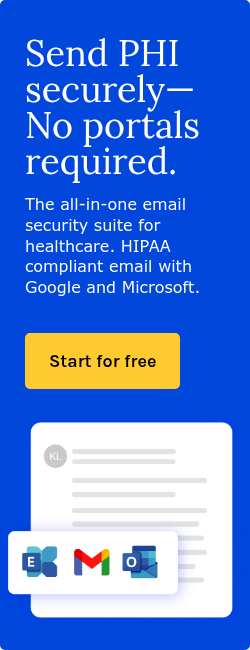7 min read
Foundations of mental health-informed healthcare and HIPAA compliance
Gugu Ntsele June 04, 2025

Throughout Mental Health Awareness Month, we've explored the importance of mental health integration, evidence-based screening and intervention approaches, and effective consultation and referral practices. Today, we end with a look at how to build a mental health-informed healthcare practice while maintaining HIPAA compliance.
The need for systemic approaches to mental healthcare integration
According to A Systemic Approach to Behavioral Healthcare Integration, "Common sense and decades' worth of data tell us that it is perilous to ignore the connection between our minds and bodies. Yet traditional clinical and training approaches segregate the biomedical and psychosocial aspects of the human experience."
The interconnected nature of mental and physical health is further emphasized in the Mental health and trauma-informed practice: companion document, which notes that "Trauma is common across the entire population, but evidence shows there is an increased likelihood that people who have experienced trauma are more likely to also experience mental health difficulties."
As noted in Identifying Core Global Mental Health Professional Competencies: A Multi-Sectoral Perspective, "Global mental health recognizes a vastly interconnected world and values nurturing that interconnectedness for solving difficult problems through a diversity of perspectives."
While individual provider education and practice changes are valuable, sustainable mental health integration requires systemic transformation. According to A Systemic Approach to Behavioral Healthcare Integration, "A systemic lens recognizes nonlinear or circular/reciprocal causality, focuses on the relationships and patterns, anticipates unintended consequences, and emphasizes the role of the system in creating lasting, intentional change."
Foundations of a mental health-informed practice environment
1. Organizational culture and leadership commitment
Successful integration begins with leadership that values mental healthcare as core to the organization's mission, allocates appropriate resources for mental health services and training, establishes mental health metrics as performance indicators, and supports staff in developing mental health competencies.
As noted in the companion document, "Taking an approach or lens of 'what happened to you?' rather than 'what's wrong with you?' is central to working with people who have experienced trauma by building trust and understanding and reframing interactions between the workforce and people using services."
The Systemic Approach article provides, "Successful integration implementation requires shifting healthcare structures, team dynamics, and communication and behavior patterns. As with families, the healthcare system has a strong pull to homeostasis that can derail change efforts."
2. HIPAA compliance infrastructure
Mental health integration requires privacy protections across multiple domains:
- Policy development: Organizations need specialized mental health privacy policies beyond general HIPAA requirements, procedures for identifying and segregating specially protected information, guidelines for applying minimum necessary standards to mental health information, clear protocols for handling authorization exceptions, and breach response plans specific to mental health data incidents.
- Staff training: Effective programs include role-specific education on mental health privacy requirements, case-based learning addressing common scenarios, regular updates on regulatory changes affecting mental health information, competency validation for handling sensitive information, and resources for addressing complex disclosure questions.
- Technical safeguards: Essential elements include EHR configurations that appropriately protect psychotherapy notes, access controls aligned with clinical roles and responsibilities, audit capabilities for monitoring access to sensitive information, secure messaging systems for mental health communications, and data segmentation capabilities for specially protected information.
3. Physical environment considerations
As noted in Cultural competence in mental health care: a review of model evaluations, "Health professionals are now more aware of the challenges they face when providing healthcare to a culturally and racially diverse population."
The physical space of healthcare settings influences mental healthcare delivery. Organizations should provide private spaces for screening and discussion of sensitive topics, soundproofing for confidential conversations, waiting areas designed to reduce anxiety and psychological distress, crisis response spaces for managing acute psychological emergencies, and dedicated areas for telehealth services with privacy protections.
Read also: Implementation strategies for HIPAA compliant mental health screening
Building mental health competency across the organization
1. Tiered training approaches
According to the Systemic Approach, "The more clinicians and staff understand and engage in the implementation process, the more likely the process will be successful."
As noted in a review of model evaluations, "In order to provide culturally competent care, knowledge of cultural beliefs, values and practices is necessary otherwise health practitioners can easily fall prey to errors of diagnosis, inappropriate management and poor compliance."
Research in Identifying Core Global Mental Health Professional Competencies emphasizes the importance of competency development: "GMH competencies will often go beyond clinical domains and incorporate health systems, leadership, advocacy, social sciences, education and training, cross-cultural navigation [...]"
Effective organizations develop competency models tailored to different roles:
- Universal competencies (All Staff): Recognition of common mental health symptoms, de-escalation techniques for distressed individuals, appropriate language and communication approaches, basic HIPAA requirements for mental health information, and resources for addressing staff's own mental health needs.
- Clinical support staff competencies: Administration and scoring of screening instruments, recognition of mental health emergencies, patient education regarding mental health resources, documentation practices that maintain privacy, and scheduling approaches for mental health follow-up.
- Clinical provider competencies: Evidence-based assessment approaches, diagnostic formulation for common conditions, first-line intervention skills, collaborative care coordination with mental health specialists, and documentation that meets both clinical and legal requirements.
- Leadership and administrative competencies: Mental health program development and evaluation, quality metrics for mental health integration, resource allocation for behavioral health services, compliance oversight for mental health privacy, and building provider networks that include mental health.
2. HIPAA compliant training documentation
Training activities themselves create HIPAA compliance documentation through competency assessments demonstrating staff preparedness, attendance records for required privacy training, documentation of case-based learning addressing mental health privacy, regular updates reflecting changing regulations, and role-specific education aligned with information access levels.
3. Learning formats and approaches
According to a review of model evaluations, "The voluntary desire to become culturally competent was seen to reflect an important general attitude towards work with culturally diverse groups."
Effective mental health competency development utilizes diverse approaches:
- Case-based learning: Application of knowledge to realistic scenarios, complex decision-making regarding disclosure and privacy, documentation practice with feedback.
- Simulation training: Communication skills practice with standardized patients, crisis response rehearsal, handling difficult conversations about mental health, and team-based management of complex situations.
- Mentored experience: Supervised clinical encounters with real-time feedback, chart review with attention to documentation quality, consultation skills development, and gradual autonomy in managing increasingly complex cases.
Developing HIPAA compliant clinical workflows
HIPAA compliant foundations for integrated behavioral healthcare workflows
Developing HIPAA compliant clinical workflows for integrated behavioral healthcare begins with establishing the principles that guide both care delivery and privacy protection. As noted in A Systemic Approach to Behavioral Healthcare Integration, "a central tenet of integrated care is to meet people where they are. Integrated care literally provides behavioral health services where the public seeks healthcare." This accessibility principle must be balanced with privacy requirements, particularly when working with mental health information.
As Cultural competence in mental health care: a review of model evaluations explains, "a culturally competent person is able to acknowledge, accept, and value the cultural differences of others. That is, such a person has the knowledge and skill that enable him or her to appreciate value and celebrate similarities and differences within, between, and among culturally diverse groups."
Privacy-protected patient intake and assessment workflows
HIPAA compliant clinical workflows require patient intake and registration processes that integrate mental health screening while maintaining appropriate privacy protections. These workflows include specialized registration materials with privacy notices addressing mental health information specifically, authorization forms for appropriate information sharing, and plain language explanations of privacy rights. Staff interactions must occur in private spaces with established scripts for explaining confidentiality provisions, while EHR documentation captures privacy preferences and implements alerts for special consent requirements. Screening and assessment workflows demand thoughtful process design that incorporates HIPAA compliance elements including secure transmission of screening data, appropriate access controls for results, and clear responsibility assignment for follow-up care.
Secure documentation and care coordination workflows
The development of HIPAA compliant clinical workflows extends to treatment planning and documentation systems that support integrated care while protecting patient privacy. These systems utilize shared care planning templates, clinical decision support features, and privacy-enhancing capabilities such as separation of protected information and granular permission settings. Care coordination workflows require HIPAA compliant information exchange mechanisms including authorization tracking systems, minimum necessary determination supports, and secure transmission methods.
Real-world implementation: Orcas behavioral health case study
Background and context
Orcas Behavioral Health (OBH), a community mental health center in the Pacific Northwest, serves a mixed rural and urban population of approximately 250,000 residents, OBH operates with 450 staff members, a $31 million annual budget, and serves over 7,000 clients per year. The majority of their client population is low-income and receives Medicaid or Medicare benefits.
Implementation journey
Initial motivation and grant funding
OBH's integrated care implementation was "facilitated through a combination of leadership passion and a three-year $1.8 million CMMI grant." The motivation stemmed from executive leadership's recognition that clients were experiencing preventable deaths due to inadequate access to primary care services. As one participant noted, the agency was committed to this model "regardless of the grant because it was the type of work that was needed."
Systematic implementation process
The implementation followed the Exploration, Preparation, Implementation, and Sustainability (EPIS) framework, demonstrating how systematic approaches can guide integrated care development in community mental health settings.
Implementation strategies
1. Collocated care model
OBH implemented a collocated primary care and behavioral health integrated care model by physically relocating staff from separate wings into multidisciplinary teams. This spatial proximity facilitated impromptu consultation between team members and enhanced drop-in access for clients.
2. Workforce development and training
The agency invested in staff competency development through training in multiple evidence-based practices including:
- Cognitive Behavioral Therapy
- Dialectical Behavioral Therapy (DBT)
- Motivational Interviewing
- Trauma-Focused Cognitive Behavioral Therapy
- Screening, Brief Intervention, and Referral to Treatment (SBIRT)
- Patient Activation Measure (PAM)
3. HIPAA compliant data systems
OBH developed health data collection systems that tracked:
- Primary care physician relationships
- Date of last PCP visit
- Smoking status
- Substance use diagnosis
- Blood pressure and body mass index
- Other chronic disease measures
Medical assistants served as primary data collectors, though the agency later discovered that they "spent a lot of time pulling together behavioral health data and primary care data" but clinicians weren't effectively utilizing the reports.
Success factors identified
Based on OBH's experience, the case study identified four elements for successful integrated care implementation:
- Flexible workforce: Teams must transcend traditional professional disciplines and power dynamics
- Shared definition: Clear, consistent understanding of integrated care components and processes
- Policy and funding congruence: Alignment between agency practices and state/federal regulations
- Ongoing support and training: Sustained consultation and skill development beyond initial training
HIPAA compliance considerations
The case study showed multiple HIPAA-related challenges in integrated care:
Data privacy complexities
OBH experienced difficulties with differing privacy requirements between mental health and substance use disorder treatment, noting: "data privacy differences between mental health and SUD treatment have limited the agency's ability to communicate with emergency departments."
Information sharing barriers
The agency struggled with 42 CFR privacy thresholds, finding it confusing when clients mentioned casual alcohol use: "people can say, 'oh I had a few beers this weekend,' so does that cross the 42 CFR threshold or not?"
Implications for other organizations
OBH's experience demonstrates that successful integrated care implementation requires:
- Strong leadership commitment that persists through financial challenges
- Systematic planning using established implementation frameworks
- Realistic expectations about the time required for culture change
- Ongoing attention to HIPAA compliance in complex service environments
- Sustainable funding models beyond initial grant periods
- Clear role definitions and interprofessional collaboration strategies
FAQs
How can small practices begin integrating mental health services without large budgets?
Small practices can start by training existing staff in basic mental health competencies and establishing referral networks with mental health professionals.
What role can patients play in promoting integrated care?
Patients can support integration by actively participating in care planning and voicing mental health concerns to their providers.
How do providers navigate mental health documentation across different state privacy laws?
Providers must stay informed of both HIPAA and applicable state-specific privacy laws, seeking legal counsel when necessary.
Can telehealth be effectively used for integrated behavioral care?
Yes, telehealth can expand access to integrated care when it includes secure platforms and appropriate training for virtual engagement.
What are common challenges in staff buy-in for mental health training initiatives?
Staff resistance often stems from time constraints, perceived irrelevance, or lack of institutional support.
Subscribe to Paubox Weekly
Every Friday we'll bring you the most important news from Paubox. Our aim is to make you smarter, faster.




